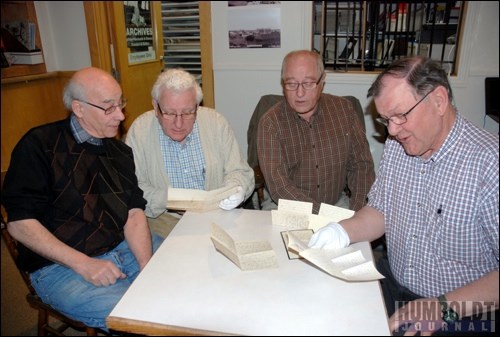Letters. Photographs. And even a lock of hair.
These small items of great historic value to the Humboldt region were recently donated by the Weldon family to the Humboldt and District Museum and Gallery.
And the HDMG couldn't be more excited about it.
George and Catherine Weldon, along with their daughter, were the first people who lived in Humboldt. They called the Humboldt Telegraph Station, located southwest of the present city, home between 1878 and 1882.
The Weldons' daughter, Ann Jane Weldon, fondly known as Birdie, spent her early childhood years at the telegraph station. Sadly, she died there on January 28, 1882 at the age of four from an abscess behind her tonsil.
She was taken to Prince Albert for a Christian burial - the closest point where there was a resident minister.
This was a heartbreaking time for the Weldon family, and that is apparent in the letters that form part of the donation to thee HDMG, most sent to Catherine and George in response to the news of Birdie's death.
The letters and other artifacts were given to the HDMG by Cindy Sauer, the great-granddaughter of George and Catherine Weldon, who now lives in Niagara Falls, ON. Her grandfather was Charles Weldon, the son of George and Catherine, who was born after they left Humboldt.
"I know that when I sent the articles to you that they would be well taken care of," Sauer wrote in an email to Jennifer Hoesgen, HDMG director.
"I also was fully confident that at the museum, they would be safe and available for folks to see part of the Humboldt history as well," she continued.
Wearing gloves to protect the artifacts from damage, Hoesgen sorted through the letters and the photos, and opened up a tiny box, which contained a rather unusual artifact - a lock of Birdie's hair, sent it seems, from one of the letters, to family after Birdie had died.
This artifact seems to astound Hoesgen.
"Birdie was only here for four short years," she said, shaking her head. "And 130 years later, we get a lock of hair from the baby who was at that site."
The letters of condolence written to George and Catherine came from family in Winnipeg, cousins in Indiana and friends from all over.
One letter was actually written to Birdie, in April of 1881, and spoke of a doll that her children had sent her by the last mail.
Another was written to Charles Weldon by the son of one of the men who carried Birdie's body to Prince Albert.
But the majority contain "absolute sorrow and condolences," Hoesgen said.
"It is with deep sorrow we learned of the death of your dear, good daughter," Hoesgen read from one letter.
"You loved your darling with a great love... there was no music to you like the sound of her laugh," another stated.
Some were written months after Birdie's death, Hoesgen pointed out, and express their sorrow in a way that makes it clear "they just didn't know what to say," Hoesgen said.
Others make it clear that not all their friends and family embraced the idea of the Weldons living in what was at that time the Northwest Territories.
A good friend of Catherine's, at a place Hoesgen is unsure of, wrote that the news of Birdie's death "fell on our house like a thunderbolt." Her husband, she reported, said to her, "All the comfort they had in that godforsaken country is taken from them."
She continued on to say that she wished the Weldons had not gone so far from everyone, and she doesn't understand why they chose to live out in the wilderness, where it doesn't seem the railroad will ever reach.
Other artifacts donated included a set of cufflinks containing photos of George and Catherine, George's Orangeman Sash from Ontario, Birdie's prayer book, given to her as a birthday present from her father in 1880, and photos.
A photo of Catherine is one that Hoesgen, in all her research on the family, has never seen before.
More research will be done on the letters and the artifacts to answer some of the questions raised by them - including whether sending locks of hair belonging to a lost loved one was a common practice at the time, and other small details of life at the time.
The letters, due to their age, the writing, and the spelling of words, are difficult to read and will need in depth study, Hoesgen indicated.

.png;w=120;h=80;mode=crop)

.png;w=120;h=80;mode=crop)
